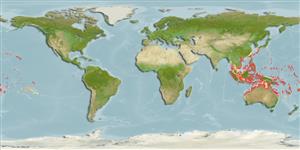Common names from other countries
Environment: milieu / climate zone / depth range / distribution range
Ecología
marino asociado a arrecife; rango de profundidad 2 - 60 m (Ref. 128797). Tropical; 32°N - 28°S
Indo-Pacific: Western India to Pitcairn Islands, north to southern Japan, south to Rowley Shoals, southern Queensland, and New Caledonia; throughout Micronesia.
Tamaño / Peso / Age
Maturity: Lm ? range ? - ? cm
Max length : 18.0 cm TL macho / no sexado; (Ref. 9710)
Espinas dorsales (total): 12 - 13; Radios blandos dorsales (total): 21-22; Espinas anales 0; Radios blandos anales: 17 - 18.
Common in coral-rich areas of subtidal reef flats and lagoon and seaward reefs. Juveniles solitary and usually found in estuaries and lagoons; adults usually in pairs (Ref. 48636). Feed mainly on coral polyps. Oviparous (Ref. 205). Form pairs during breeding (Ref. 205). Minimum depth reported taken from Ref. 30874.
Life cycle and mating behavior
Madurez | Reproducción | Puesta | Huevos | Fecundidad | Larva
Form pairs during breeding (Ref. 205).
Myers, R.F., 1991. Micronesian reef fishes. Second Ed. Coral Graphics, Barrigada, Guam. 298 p. (Ref. 1602)
IUCN Red List Status (Ref. 130435)
CITES (Ref. 128078)
Not Evaluated
Threat to humans
Harmless
Human uses
Pesquerías: escaso valor comercial; Acuario: Comercial
Más información
ReferenciasAcuiculturaPerfil de acuiculturaRazasGenéticaElectrophoresesheritabilidadEnfermedadesProcesamientoMass conversion
Herramientas
Special reports
Download XML
Fuentes de Internet
Estimates based on models
Preferred temperature (Ref.
115969): 24.7 - 28.9, mean 27.8 (based on 554 cells).
Phylogenetic diversity index (Ref.
82804): PD
50 = 0.5039 [Uniqueness, from 0.5 = low to 2.0 = high].
Bayesian length-weight: a=0.01995 (0.01265 - 0.03147), b=3.09 (2.95 - 3.23), in cm Total Length, based on LWR estimates for this species & (Sub)family-body (Ref.
93245).
Nivel trófico (Ref.
69278): 3.8 ±0.3 se; based on diet studies.
Resiliencia (Ref.
120179): Alto, población duplicada en un tiempo mínimo inferior a 15 meses (Preliminary K or Fecundity.).
Fishing Vulnerability (Ref.
59153): Low vulnerability (10 of 100).
